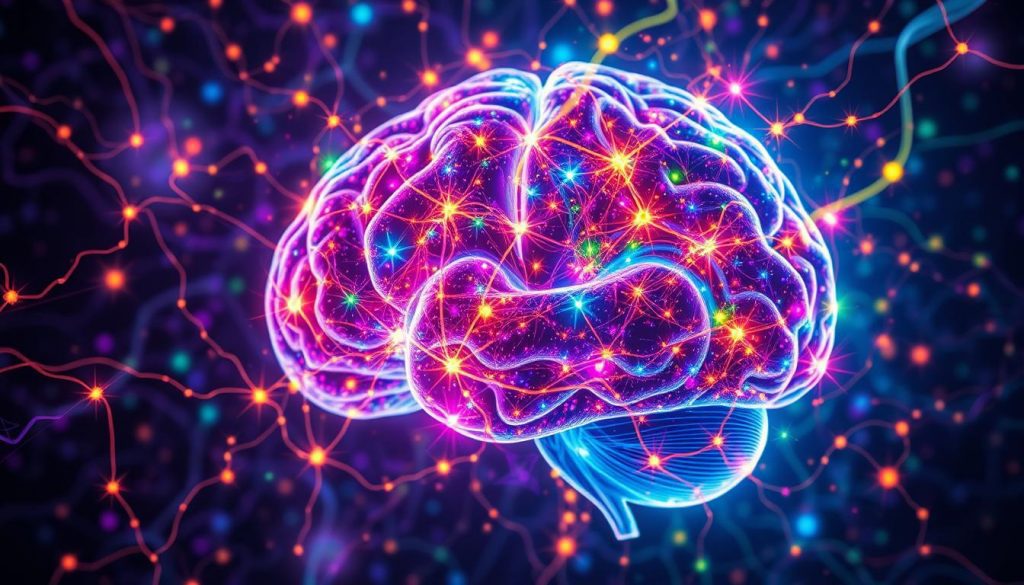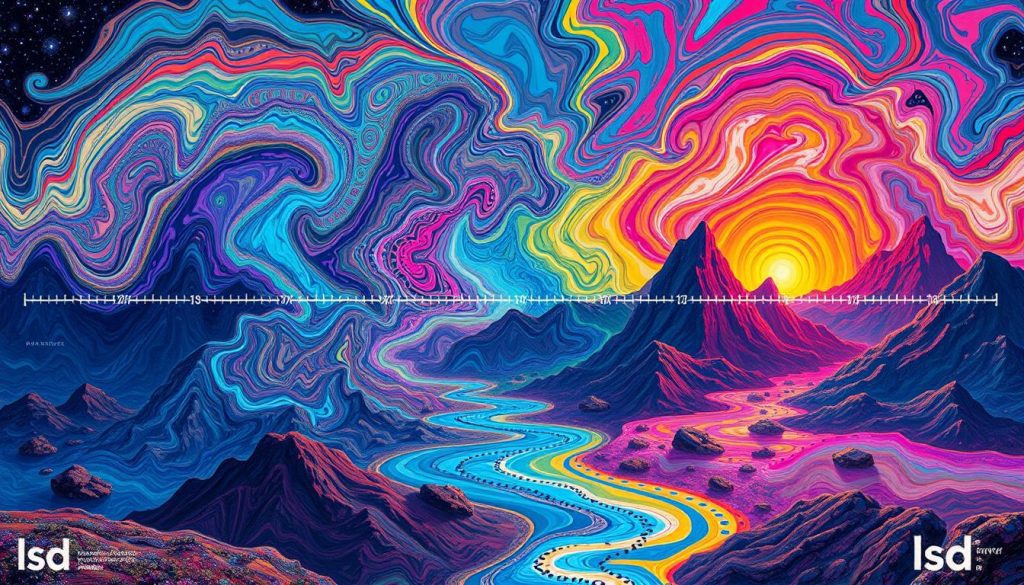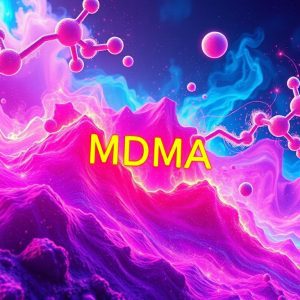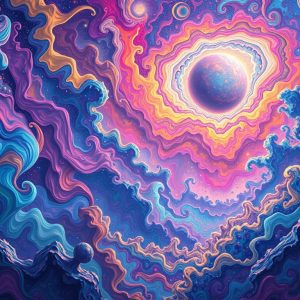Description
Imagine a single drop could unlock your mind’s secrets. Would you leap? LSD, a powerful substance, is at the center of debates about its impact on our minds. It challenges our perceptions, offering a deep dive into its role in culture and personal exploration. This piece aims to show the LSD effects trip without judgment.
LSD has seen its fair share of ups and downs in public opinion. Some see it as a tool for self-discovery and healing, while others fear it as a dangerous escape. We aim to explore LSD’s complex nature, looking at its immediate and lasting effects on those who try it.
Key Takeaways
- Comprehensive understanding of the immediate and long-term effects of LSD on the mind and body.
- Insight into the psychedelic impact of LSD on consciousness and perception.
- Evaluation of both positive and negative aspects of LSD use, aimed at informed awareness.
- Discussion of LSD’s controversial standing in society and its polarizing perceptions.
- Exploration of LSD trip experiences and their significance in psychedelic research.
As we continue, get ready for a complete look at LSD. We’ll cover the science, the senses, and society’s views. Together, these threads create the full picture of LSD’s effects.
An Overview of LSD and Its Place in Psychedelic Research
LSD, or lysergic acid diethylamide, is a key focus in psychedelic research. Its history and effects on the mind are complex. It has played a significant role in both culture and medicine.
Historical Context of LSD Use
Swiss chemist Albert Hofmann discovered LSD in 1938. It was first made for other uses but turned out to be very psychedelic. In the 1950s and 60s, it was used in therapy to understand the mind and treat mental health issues.
LSD in Modern Scientific Studies
LSD is now being studied again. Scientists are looking at its use in treating depression, PTSD, and anxiety. They want to see LSD as more than just a recreational drug.
Recreational Use vs. Therapeutic Potential
LSD has two sides. It’s used recreationally for its effects, but it can also be misused. On the other hand, it’s being studied for its potential to help with mental health. This shows a fine line between its benefits and risks.
| Aspect | Recreational Use | Therapeutic Use |
|---|---|---|
| Perception | Often associated with cultural and social experiences | Seen as a promising treatment for various mental health conditions |
| Legal Status | Generally illegal, varies by country | Restricted to controlled clinical trials |
| Main Proponents | Recreational users, psychedelic enthusiasts | Scientists, psychotherapists, medical professionals |
| Risks | Potential for abuse and psychological distress | A controlled environment minimizes risks |
LSD Effects on the Brain and Consciousness
LSD works by mimicking serotonin in the brain, affecting many neural circuits. It binds to serotonin receptors, like the 5-HT2A subtype, causing changes in how we see, feel, and think. This action changes how the brain handles reality and emotions.
Research into LSD’s effects on the brain has shown it increases brain connections. This leads to changes in how we experience the world. It’s why LSD can alter our thoughts and sense of self, impacting both our psychology and consciousness.
This enhanced connectivity is widespread and includes networks that typically operate independently. This wide integration of brain networks is thought to be key to the altered state of awareness LSD causes. Thanks to its effect on neuroplasticity, it also hints at its potential therapeutic benefits.
| Brain Function | Effect of LSD |
|---|---|
| Sensory Perception | Heightened and distorted sensory experiences |
| Emotional Response | Heightened emotional awareness, sometimes resulting in euphoria or distress |
| Cognitive Processing | Disorganized thought patterns, insights, and epiphanies |
| Self-awareness | Altered sense of self, leading to experiences of ego dissolution |

The findings from these studies are more than just interesting. They show LSD’s potential for treating mental health issues. By changing how the brain is organized, LSD offers a new way to look at problems. This highlights the link between LSD’s effects on the brain and its impact on our consciousness.
Phases of an LSD Trip Experience
An LSD trip can change how you see, feel, and experience time. Knowing the different stages helps us understand how it affects people.
The Onset of Effects
The trip starts with the onset of LSD effects, which can take 20 to 90 minutes. You might notice changes in how you see things. Colors seem brighter, and patterns appear.
This first part is important because it sets the stage for what’s to come. It leads to more intense experiences.
Peak LSD Experiences
The peak usually occurs between 3 and 5 hours after the onset and can last for hours. At this time, the effects are strongest.
People often feel deep changes in their thoughts and sense of self. Time and space seem different. Emotions can swing from joy to fear, depending on the setting and the person’s mind.
The Gradual Come Down
The trip ends with a gradual come down. This is when the effects start to fade. It can take hours to return to normal.
During this time, people often think about their experience. They might feel a mix of relief and reflection on what they learned.

The length and intensity of an LSD trip vary. It depends on the dose, body chemistry, past experiences, and the setting. While trips can last up to 12 hours, each one is unique.
Exploring the Psychological Effects of LSD
LSD creates a complex and rich world in the mind. It brings intense hallucinations, deep emotional shifts, and boosts creativity. This section looks into these effects, using both science and personal stories to understand LSD’s impact on the mind.
LSD Hallucinations and Sensory Enhancements
LSD hallucinations affect more than just sight. They can mix senses, leading to synesthesia where users see sounds or hear colors. This mix of senses creates a vivid, overwhelming experience that fascinates and intrigues many.
Emotional Shifts and Insightful Breakthroughs
LSD trips often bring sudden emotional changes. These shifts are not just mood swings. They are deep insights that help users face hidden memories, emotions, or thoughts. This can be both healing and therapeutic for many.
Impact on Creativity and Problem-Solving
LSD is known to boost creativity. It helps with divergent thinking, a key part of creative work. People in arts and sciences say LSD helps them think outside the box. It improves problem-solving and brings new ideas.
Physical Effects of LSD and Potential Side Effects
Looking into the physical effects of LSD shows a wide range of reactions. These can change a lot based on who takes it and where they are. Common signs include bigger pupils, a faster heart rate, and changes in body temperature. How strong these effects are often depends on how much LSD is taken.
LSD side effects can be different for everyone. Some people might feel sick, lose their appetite, or get dizzy. These signs show why it’s important to think about the situation and the person’s mood before using LSD.
| Physical Effect | Common Occurrence | Potential Side Effect |
|---|---|---|
| Dilated pupils | Very common | N/A |
| Increased heart rate | Common | Palpitations |
| Body temperature change | Varies | Hyperthermia or Hypothermia |
| Nausea | Sometimes | Vomiting |
| Loss of appetite | Often | Weight loss |
| Dizziness | Occasional | Vertigo |
It’s key to know about the physical effects of LSD and LSD side effects before trying it. Being aware and respectful of its strong effects can help avoid risks. It also shows the need for a safe and supportive place when using it.
Long-Term and Short-Term Effects of LSD
LSD can affect people, including thinking, feeling, and behavior changes. These changes can be short-lived or last a long time, affecting a person’s life and mental health.
Short-Term Cognitive and Emotional Implications
LSD can quickly change how people see things, feel, and experience time. Users might feel extreme mood swings, see things that aren’t there, and have hallucinations. These effects usually go away within 24 hours after taking the drug.
Long-Term Impact on Psychedelic Users
Long-term use of LSD can lead to different outcomes. Some research shows it can cause lasting changes in how people see things, known as HPPD. But other studies suggest it might help with mental health issues over time, depending on how it’s used.
Assessing the Risk of LSD Dependency
Even though LSD is not considered addictive, it can still lead to dependency. This is mainly because people might want to escape reality or feel its effects again. It’s important to note that dependency is different from addiction, as it doesn’t involve the same kind of physical cravings.
| Effect Type | Short Term Effects | Long Term Effects |
|---|---|---|
| Cognitive | Altered perception, hallucinations | Potential for HPPD |
| Emotional | Elevation in mood, anxiety | Alterations in emotional stability |
| Dependency Risk | Psychological craving to re-experience trips | Persistent psychological dependency |
Conclusion
In this article, we explored the complex world of LSD effects. We looked into how LSD changes our perception, thoughts, and feelings. This is just a glimpse into this powerful substance’s vast potential and dangers.
Research is key to understanding LSD. It helps us see how it can be used for good while also being careful about its risks. We need to talk about LSD in a way that is both safe and curious, respecting its power and its role in science and society.
It’s important to talk about LSD based on real research. People who try LSD should know what it can do. Learning about LSD is a journey that needs caution and ongoing education. This article aimed to show the many sides of LSD, helping us understand it better.







Reviews
There are no reviews yet.